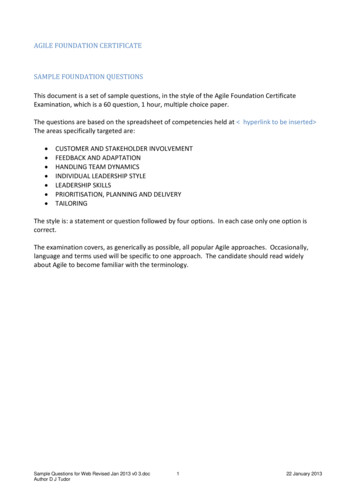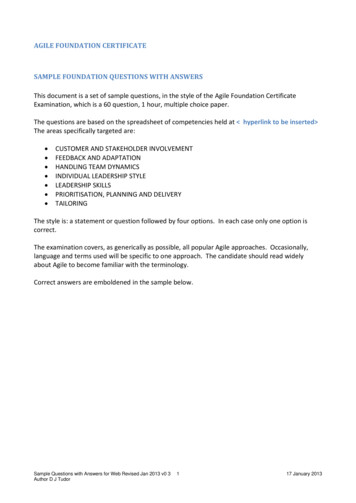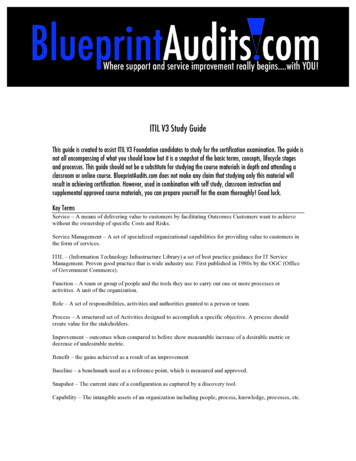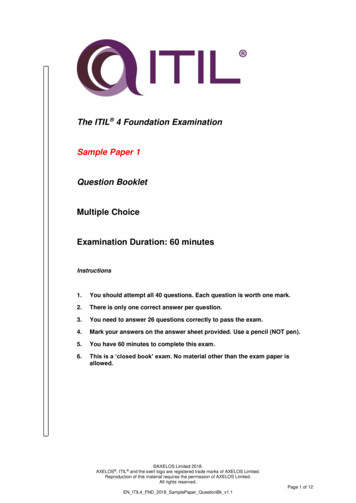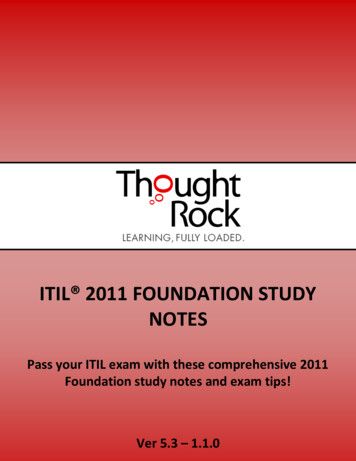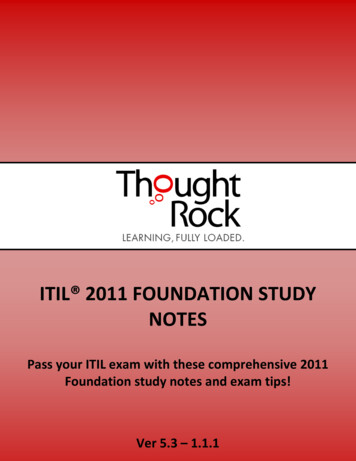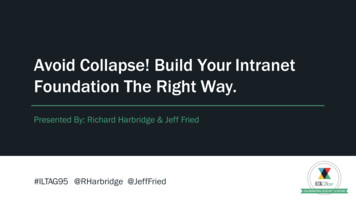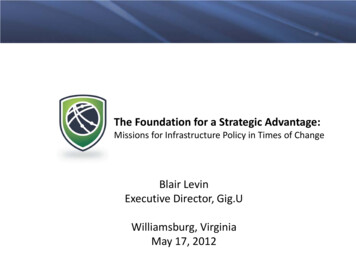
Transcription
The Foundation for a Strategic Advantage:Missions for Infrastructure Policy in Times of ChangeBlair LevinExecutive Director, Gig.UWilliamsburg, VirginiaMay 17, 2012
Responding to Change is Not Easy “The danger in times ofturbulence is not theturbulence. It is to actwith yesterday’s logic”– Peter F. Drucker
Today’s logic: How would the United States have a strategicadvantage in the 21st Century Economy?Table Stakes: Having an advantage in access tothe key inputs for economic growthBroadbandEnergy Cheap, AbundantBandwidth Both Fixed and Mobile Cheap, Abundant Energy Moving from Carbon toRenewable2
Is this is our current path in the United States in wire line?We areMid-tieranddroppingCategory/DateJanuary 2012April 2012Download Speed3135Upload Speed3745Quality3838Cost Per Megabit2917And most of the world’s fastest cities are in Asia or Europe.Source: Ookla3
Market forces are not providing critical mass ofworld leading networks in U.S.Verizon has stopped the FiOS Build we will accelerate our efforts to improve our overallgrowth profile. We will do that by looking atopportunities to either divest or restructure lowperforming and nonstrategic assets.And AT&T islooking to sellwire line assetsAT&T Chairman and CEO Randall Stephenson, January26, 20124
Current MarketFor the first time since the beginning of the commercial internet, there are no plansfor a national wired provider to build a faster network than the leading networkDOCSIS 3.0FIOS, UVerseTelco PlansTelco DSL2G Cable BBDial-UpCable BBDoes it matter thatinstead of discussingupgrades, incumbentsare discussing datacaps?Time5
And what does that mean for where will we be in April, 2015?Category/DateJanuary 2012April 2012April 2015Download Speed3135?Upload Speed3745?Quality3838?Cost per Megabit2917?6
Agenda The Role of High Performance Knowledge Exchange The Traditional Three Missions of Policy The Two New Critical Missions of Policy Common Lessons for Driving Change in Bandwidth andEnergy THE UPGRADE FOR INNOVATION: GIG.U7
THE ROLE OF HIGH PERFORMANCEKNOWLEDGE EXCHANGE8
Underlying EverythingHow can communicationspolicy set priorities toserve that mission?What is the mission of state policy inthe 21st Century?9
Underlying the State MissionImprovedSocietyEconomicGrowth andOpportunityHigh PerformanceKnowledge Exchange10
The Management Challenge:Productivity of Knowledge Work The most important, and indeed the trulyunique, contribution of management in the 20thcentury was the fifty-fold increase in theproductivity of the manual worker inmanufacturing. The most importantcontribution management needs to make in the21st century is similarly to increase theproductivity of knowledge work and knowledgeworkers. The most valuable assets of a 20thcentury company was its production equipment.The most valuable asset of a 21st- centuryinstitution (whether business or non-business)will be its knowledge workers and theirproductivity. .It is on (the productivity ofknowledge work), above all, the the futureprosperity-and indeed the future survival ofdeveloped economies will increasingly depend.”– Peter F. Drucker “Knowledge-workerproductivity: the biggest challenge”
It is on (theproductivity ofwork),The mostknowledgeimportant, and indeedthe trulyunique, contributionof managementin the 20thaboveall,thethecentury was the fifty-fold increase in thefutureprosperity-andproductivityof themanual worker inmanufacturing. The most importantindeed the futurecontribution management needs to make in the21st centuryis similarlyto increase thesurvivalof developedproductivity of knowledge work and knowledgeeconomieswillof a 20thworkers. Themost valuable assetscenturycompany was its productionequipment.increasinglydepend.”The most valuable asset of a 21st- centuryinstitution (whether business or non-business)will be its knowledge workers and theirproductivity. .It is on (the productivity ofknowledge work), above all, the the futureprosperity-and indeed the future survival ofdeveloped economies will increasingly depend.”– Peter F. Drucker “Knowledge-workerproductivity: the biggest challenge”
A Quick Look Back AtTechnology and Progress From First Centuryto 1500,population andGDP increase atconstant ratearound world(Malthusian Trap)BuBut something got us out of that trap.
The Industrial Revolution
Continuing Innovation and Growth Unlike earlier technology developments in China, Islamic Golden Age, innovationwas not isolated period of ongoing; rather growth has continued due to“combinatorial innovation”---the process of knowledge building upon knowledge
ProductivityNew inputs drive economic growth1800’s Access to new forms of power (steam engines) Access to new forms of transportation (canals, thentrains)1900’s Access to new forms of power (electricity) Access to new forms of transportation (cars, trucksand planes)2000’s Access to computing powerNew energy yet Access to data storageto come Access to digital communicationsFastest growing parts of the economy are thosethat best use new inputs16
CollectionThese Two Concepts Come Together in theFundamental Task of Knowledge he Foundation for Combinatorial InnovationRevisedCourse ofActions
The Fundamental Task of Knowledge ExchangeCollectionTransformed by New InputsThe taRevisedCourse ofActionsThe CommunicationsRevolutionThe Big DataRevolutionFeedbackChanges in Inputs Now EnableHigh-Performance Knowledge Exchange
ProductivitySuch changes are key to productivity growthContribution to long-term productivity growth11%37%Improvedlabor qualityTechnologicalchange and otherfactorsCapital investment19Data: US Bureau of Labor Statistics
ProductivityThe biggest leaps in growth are driven by meta-ideasImproving the exchange of informationimproves the conditions for innovation.GatherinformationRevisecourse ofactionAnalyzeinformationAct on it“Parallel experimentation bymillions of entrepreneurs isthe best and fastest way (todrive innovation)”Brynjolfosson and McAfee20
Broadband is the common platform forknowledge exchangeNetworksUsersBroadband EcosystemProductivityInnovations Succeed or FailBased on Whether there is aVibrant EcosystemThe Wide Lens: A New Strategyfor InnovationDevicesApplicationsImprovements in each element of the ecosystemdrive improvements in others in a virtuous cycle.21
Knowledge Exchange Not Just a Service, High-Tech Sector Issue:Now Core to All Parts of the EconomyManufacturing Enables just-in-time assembly Critical for supply side managementAgriculture Affecting real time decisions as to weather, prices Enables new business models (CommunitySupported Agriculture)Construction Mobile broadband now essential on constructionsites for scheduling, supplies, coordination Broadband networks used for site securityRetail RFID revolutionizing inventory control Broadband networks used throughout shippingand transport process for retailAlso, it is critical to core tasks of society, such as education, public safety, health careand civic engagement, which are at their core primarily about knowledge exchange
THE TRADITIONAL THREE MISSIONSOF POLICY23
The Traditional 3 MissionsGetting Networks EverywhereGetting Everyone OnHaving A Competitive MarketDynamic That Drives Innovation andConsumer Benefits24
Access--TraditionalHow Do WeGetNetworksEverywhere? Providing baseline level ofservice to most rural ofresidents Accomplished by a subsidycollected from telephonerevenues; urban to rural,business to residential, andlong-distance to local In power, accomplished aswell by direct governmentsubsidy to high-cost areas25
Adoption---TraditionalHow DoWe GetEveryoneOn? Generally done by taxingall users to subsidizeservice and equipmentfor low-income persons,both in communicationsand energy Also involves subsidizinginstitutions that serveunder-adoptingcommunities26
Competition---TraditionalHow Do WeHave ACompetitiveMarketDynamic thatDrivesInnovation andConsumerBenefits? Merger reviews Spectrum screens;availability Unbundlingrequirements Accessrequirements27
Access---New IssuesHow Do WeGetNetworksEverywhere? Need both fixed and mobile,with shifting levels of services Mixture of fiber and spectrum Need to avoid subsidizing pastbusiness models in ways thatembed their advantage Need to find new financing basefor support of high-cost networks Need way to address carrier oflast resort obligations andstranded investment How do we get the rightnetworks to the right places28
Access---New PrioritiesHow Do WeGetNetworksEverywhere? How do we efficiently usespectrum/Digital Dividend How do we use unlicensed toopen up options How do we use fiber as deep aseconomically efficient How do we connect networkswith new energy sources totraditional access networks How do incent incumbents toemerge from their silos tobetter use existing assets?29
Adoption—New IssuesHow DoWe GetEveryoneOn? How do we createrelevance? What kinds ofdevices/servicesrequire subsidy? How do we providetraining for multiplelayers of literacy?30
Competition--NewHow Do WeHave ACompetitiveMarketDynamic thatDrivesInnovation andConsumerBenefits? How do we enable both longterm investment and new modelsto emerge? How do we allow collaborationthat does not enable anticompetitive behavior? How do we address value chaincompetition? How do enable highperformance knowledgeexchange to drive improvedenergy use (data apps on smartgrids)31
THE TWO NEW CRITICAL MISSIONSOF COMMUNICATIONS POLICY32
The New Two MissionsUsing The Networks Betterto Achieve Economic andPolicy GoalsCreating a StrategicAdvantage33
UseHow DoWe UseTheNetworksBetter? How can we use tobetter deliver healthcare, education, publicsafety? How can governmentsuse networks to driveeconomic growth? How can networksimprove thedemocratic process?34
National Purposes:Broadband is part of the solution to many of the country’s problemsNational PurposesHealth CareEnergy/Environment Electronic healthrecords Smart grid Remote/ homemonitoring Mobilemonitoring Telemedicine Smart homeapplications Smarttransportation Telework HealthinformationexchangeInnovationand ortunity AmericanGraduationInitiative Service deliveryand efficientgovernment Job creation andeconomicdevelopment STEM Improvedperformance Job training andplacement Transparency Communitydevelopment Nat’l Ed TechPlan eBooks andcontent Civicengagement Electronicstudent datamanagement PolicyInclusivenessPublic Safety Interoperablemission criticalvoice andbroadbandnetwork Next-gen 9-1-1 Alerts CybersecurityConsumer Welfare
Use—New QuestionsHow DoWe UseTheNetworksBetter? How cangovernment bedata driven? What governmentagencies shouldbe eliminated? When can we getrid of paper?36
What Platform is Best for Our Kids: Gutenberg’s or Digital? Options for student who does notunderstand: None Options for student who does not understand:multiple Updated: Twice a decade at big cost Updated: Whenever at little cost Effectiveness hard to test Easy to test effectiveness Restricted to text and pictures Can use multimedia and communications Expensive to distribute Inexpensive to distribute Provides no data to teachers, boardor parents Can provide constant, actionable data toteachers, board and parents
UseBut need complete ecosystem to workNetworks Spectrum access toavoid new digitaldeviceUsers Newopportunities/dangersfor literacyBroadband EcosystemGovernment Role,Coordination EssentialDevices Market producingApplications Rules often prohibit38
Strategic Bandwidth--TrendsHaving Big DataAbundantRevolutionBandwidth to Two Way VideoTakeCollaborationAdvantage of Enabling HighHighBandwidthBandwidthDevicesOpportunities39
Strategic Bandwidth—New QuestionsHavingAbundantBandwidth toTakeAdvantage ofHighBandwidthOpportunities How do markets createbandwidth for innovation whenthe markets have been designedfor mass consumption? How do we recognize need fordifferent kinds of networkswithout losing the benefits of allbeing served by similar networks? How do we provide an incentivefor networks that drive apsychology of abundance, ratherthan a psychology of scarcity40
Bandwidth, unlike dial-tone, has multiple variablesWhat does aFarmer anda Doctorneed?25 yearsagoTodayDial toneDial ToneMobile DataEnough Bandwidth forreal time collaborationwith an MRI41
Research facilities are moving to 100 Gbpsconnections“National LambdaRailprovides 100 GigabitConnection for NOAA atSupercomputing 2011. NextGeneration ResearchCapabilities Will BeDemonstrated Using CiscoTechnology and NLR TransportNetwork”Competition“Research institute deploys100 Gigabit Ethernet from coreto closet”By Shamus McGillicuddy, November 28, 2011By Bizjounrals.com, November 7, 201142
Data RevolutionNew Devices Require Much Higher Bandwidth“DNA Sequencing Caught in Deluge of Data”By Andrew Pollack, New York Times, November 30, 2011BGI, based in China, is the world’s largest genomics researchinstitute, with 167 DNA sequencers producing the equivalentof 2,000 human genomes a day.BGI churns out so much data that it often cannot transmit itsresults to clients or collaborators over the Internet or othercommunications lines because that would take weeks.Instead, it sends computer disks containing the data, viaFedEx.Other Such Devices Include 4K Cameras and Robots43
ProductivityBarrierSociety Needfor An UpgradeBasic Math foran Upgrade44
Market ForcesThe returns do not justify the investmentFor the incumbent, the equation usually looks like this:CostsBenefitsC O (1-r)R SB (-CL)C – Capital ExpendituresO– Operating Expendituresr – RiskR- RevenuesSB- System Benefits(Benefits that drive increased revenues outside the communities wherethe new or incremental investments are made
Download Speed ; 31 ; 35 . Upload Speed ; 37 . 45 ; Quality . 38 ; 38 . Cost Per Megabit ; 29 . 17 ; And most of the world’s fastest cities are in Asia or Europe. Source: Ookla We are Mid-tier and dropping we will accelerate our efforts to improve our overall growth profile. We will do that by looking at opportunities to either divest or restructure low performing and nonstrategic assets .
